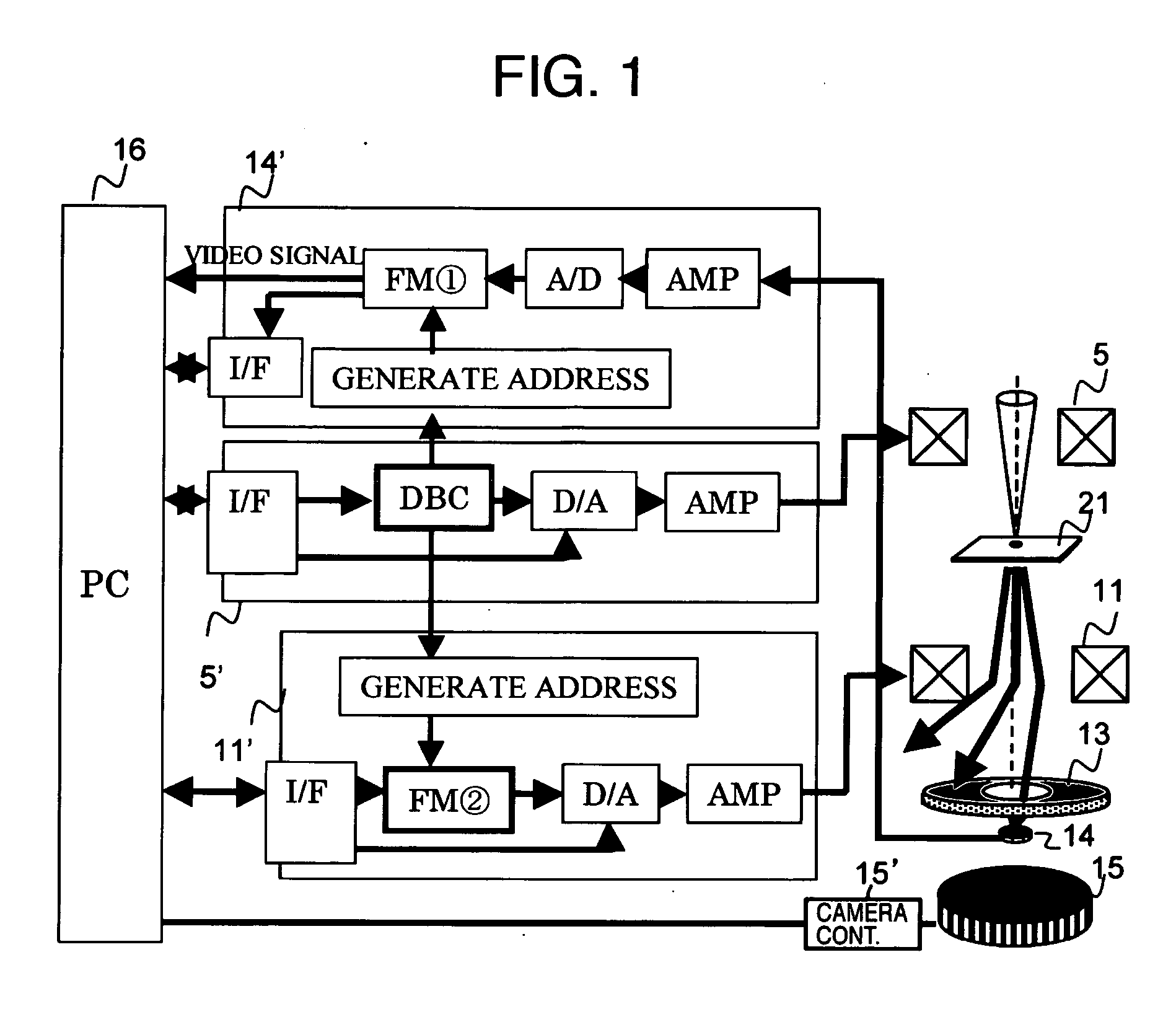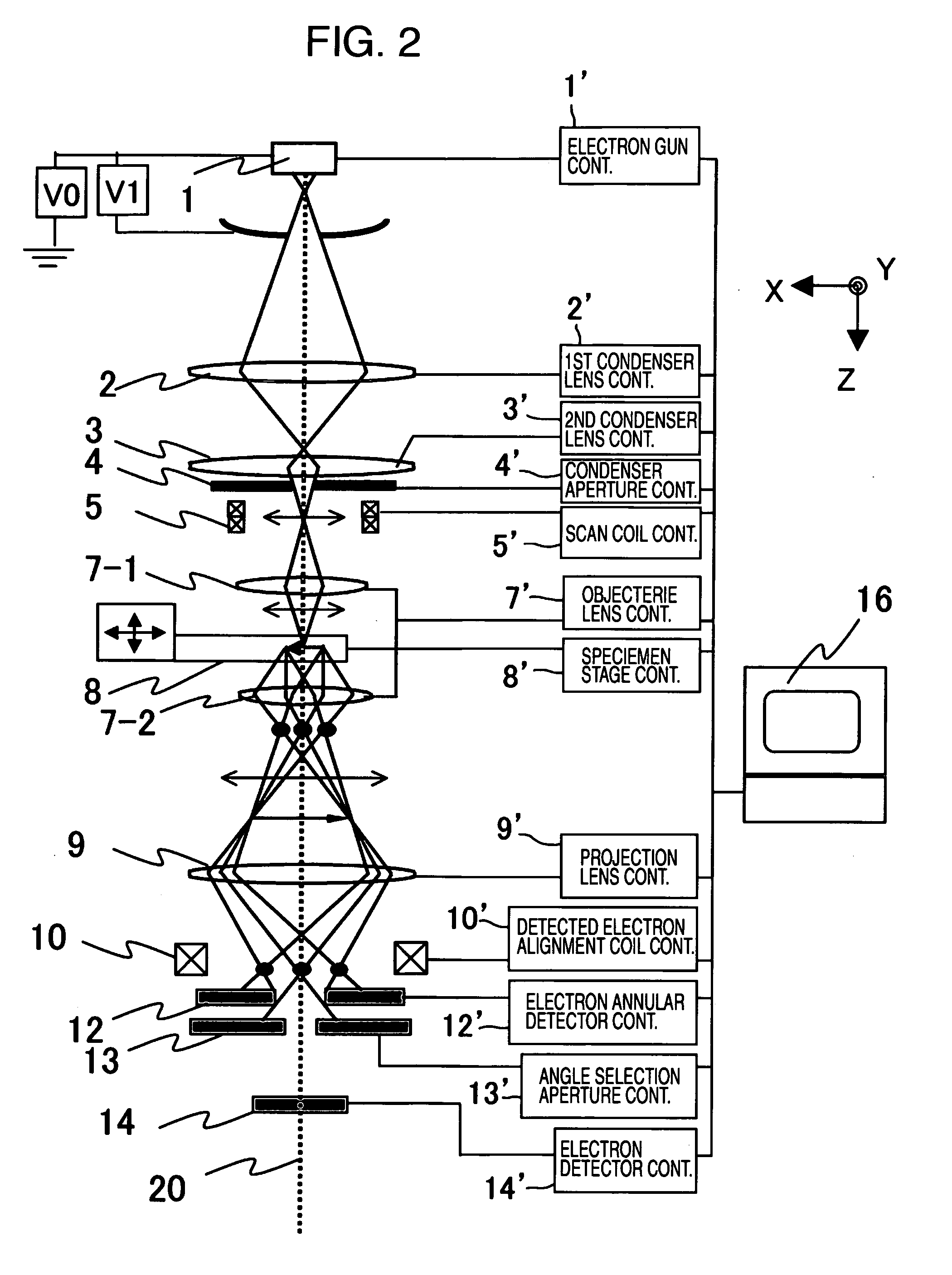Scanning transmission electron microscope and scanning transmission electron microscopy
a transmission electron microscope and scanning technology, applied in the field of scanning transmission electron microscopes, can solve the problems of unnecessary complicated and troublesome adjustment tasks, complicated and troublesome device adjustments, etc., and achieve the effects of improving the usability of the device, enlarge the field of view of the stem image, and improving the accuracy of correction accuracy
- Summary
- Abstract
- Description
- Claims
- Application Information
AI Technical Summary
Benefits of technology
Problems solved by technology
Method used
Image
Examples
embodiment 1
[0036] Hereinafter, the explanation will be given below concerning a first embodiment. FIG. 3 illustrates the basic configuration diagram of the STEM used in the present embodiment. The direction parallel to an optical axis 20 of the housing is defined as the Z direction, and the plane perpendicular to the optical axis is defined as the XY plane. The present STEM includes the following configuration components: An electron gun 1 for emitting a primary electron beam, a first condenser lens 2 and a second condenser lens 3 for forming in shape the primary electron beam emitted from the electron gun 1, a condenser aperture 4 for restricting an aperture angle of the primary electron beam, a scanning coil 5 for allowing the primary electron beam to be scanned on a specimen, an objective lens 7 for allowing focal point of the primary electron beam to be achieved on the specimen, a specimen stage 8 for holding the specimen 21, a secondary-electron detector 6 for detecting secondary electron...
embodiment 2
[0060] In the first embodiment, as the de-scanning coil 11, the one-stage deflection coil has been used which is set up between the projection lens 9 and the electron detector 14. It is also possible, however, to carry out the de-scanning by using some other coil. For example, as illustrated in FIG. 13, carrying out the de-scanning by using a two-stage deflection coil is also allowable. The two-stage deflection exhibits a disadvantage that the deflection quantity becomes smaller than that of the one-stage deflection. However, the two-stage deflection exhibits an advantage that it becomes possible to adjust both of the angle and the position of the electron beam.
[0061] Also, in order to clarify the functions of the respective coils, the detected-electron alignment coil 10 and the de-scanning coil 11 have been described in the separate manner. It is also possible, however, to implement these functions by using a single coil. Namely, if it is wished to simplify the coil control mechan...
embodiment 3
[0062]FIG. 16 illustrates a basic configuration diagram of the STEM-EELS used in the present embodiment. The EELS is installed on the lower portion of the STEM. In order to allow the transmitted electron beam to be detected by the EELS, as is the case with the angle selection aperture 13 and the electron detector 14, the electron detection camera 15 is also formed into a movable-type mechanism. The EELS includes a quadrupole lens 31, an accelerator 32, an electron spectrometer 33, a quadrupole magnifying lens 34, an energy slit 35, a mapping-use electron detector 36, a spectrum-use electron detector 37, and control units therefor.
[0063] Next, the explanation will be given below concerning processing steps for acquiring an EELS image by using the device illustrated in FIG. 16. First of all, the STEM image is acquired in accordance with the processing steps illustrated in the first embodiment. Moreover, a transmitted electron beam to which an energy spectroscopy is to be applied is s...
PUM
 Login to View More
Login to View More Abstract
Description
Claims
Application Information
 Login to View More
Login to View More - R&D
- Intellectual Property
- Life Sciences
- Materials
- Tech Scout
- Unparalleled Data Quality
- Higher Quality Content
- 60% Fewer Hallucinations
Browse by: Latest US Patents, China's latest patents, Technical Efficacy Thesaurus, Application Domain, Technology Topic, Popular Technical Reports.
© 2025 PatSnap. All rights reserved.Legal|Privacy policy|Modern Slavery Act Transparency Statement|Sitemap|About US| Contact US: help@patsnap.com



